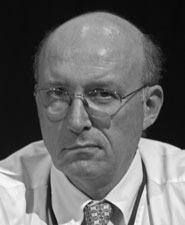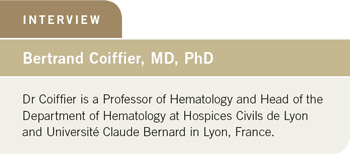You are here: Home: NHLU 5 2005 : Bertrand Coiffier, MD, PhD
 |
 |
| CD 2 — Tracks 6-17 |
| Track 6 |
Evolving role of monoclonal antibodies
in B-cell lymphomas |
| Track 7 |
Potential mechanisms of action of
rituximab with or without chemotherapy |
| Track 8 |
Use of PET scan to identify patients
at high risk after treatment
with R-CHOP |
| Track 9 |
ACVBP regimen: Dose-dense,
dose-intense CHOP followed
by short, second consolidation
therapy |
| Track 10 |
Use of dose-dense R-CHOP-14
versus standard R-CHOP-21 |
| Track 11 |
Selection of filgrastim versus
pegfilgrastim in patients
receiving R-CHOP |
|
| Track 12 |
Clinical management of mantlecell
lymphoma |
| Track 13 |
Use of R-CHOP and maintenance
rituximab for patients with
follicular lymphoma |
| Track 14 |
European versus United States
schedule and duration for maintenance
rituximab |
| Track 15 |
Value to patients of extending
duration of remission with maintenance
rituximab |
| Track 16 |
Rituximab monotherapy followed
by maintenance therapy in
patients with low tumor burden
follicular lymphoma |
| Track 17 |
ECOG-E4402 RESORT trial:
Rituximab in patients with low
tumor burden indolent NHL |
|
|
Select Excerpts from the Interview*
 CD 2, Track 9 CD 2, Track 9
 DR LOVE: What’s your usual approach to initial treatment of aggressive
lymphoma in younger patients? DR LOVE: What’s your usual approach to initial treatment of aggressive
lymphoma in younger patients? |
 DR COIFFIER: Currently, for a young patient with aggressive lymphoma, we
don’t use R-CHOP, we use a more advanced chemotherapy called ACVBP. DR COIFFIER: Currently, for a young patient with aggressive lymphoma, we
don’t use R-CHOP, we use a more advanced chemotherapy called ACVBP.
The ACVBP regimen is complicated (3.1). That’s one of the reasons it’s not
really utilized in the United States. The regimen has two parts: One part
consists of dose-dense, dose-intense CHOP, using higher doses of cyclophosphamide and doxorubicin given every two weeks for three or four cycles
according to the treatment setting. This is followed by sequential consolidation
chemotherapy, which consists of several agents — first methotrexate, then
ifosfamide, etoposide and cytarabine — every two weeks for four months. The
total length of treatment is six months.

 DR LOVE: Would you review the study of ACVBP versus CHOP that was
recently published in The New England Journal of Medicine? DR LOVE: Would you review the study of ACVBP versus CHOP that was
recently published in The New England Journal of Medicine?
 DR COIFFIER: That study included patients with localized lymphoma, but
there are other studies of ACVBP in different patient populations. DR COIFFIER: That study included patients with localized lymphoma, but
there are other studies of ACVBP in different patient populations.
The objective of our study was to demonstrate whether dose-intense chemotherapy
was better than the standard three-weekly CHOP followed by radiation
therapy. Patients in one arm received three cycles of CHOP followed by
involved-field radiation therapy. In the other arm, patients received ACVBP
and sequential consolidation chemotherapy without radiation therapy.
ACVBP with sequential consolidation chemotherapy was better than CHOP
with radiation therapy in the intent-to-treat population (3.2). If you look at
the data for patients without a large tumor mass, ACVBP was also better.
We have previously published similar findings in Blood (Tilly 2003), in which
we evaluated Stage III and IV patients and compared ACVBP to eight cycles
of CHOP.
The study was initiated before the availability of rituximab. At the time,
ACVBP was better than eight cycles of CHOP. We now know that R-CHOP is much better than CHOP, so the question is, Is R-ACVBP the same or better
than R-CHOP? We are currently investigating this question, but we do not
have the results.

 CD 2, Track 13 CD 2, Track 13
 DR LOVE: How do you approach patients with follicular lymphoma? DR LOVE: How do you approach patients with follicular lymphoma? |
 DR COIFFIER: I first evaluate the criteria for requiring treatment. I use criteria
that are nearly the same everywhere for high tumor burden. If the patient does
not have any of those criteria, I do nothing (watch and wait). If the patient
has one criterion, he or she needs to be treated. In that case, I usually propose
R-CHOP. I think there’s some benefit in adding doxorubicin. If you compare
the different studies, I think R-CHOP was better than R-CVP, and the
duration of the response is better. So I prefer to use R-CHOP in patients up
to 70 years of age. After that, R-CVP may be good treatment. If the patient
shows a good response, but not a complete response — that is, persisting low
involvement in any case — I do maintenance therapy with rituximab. DR COIFFIER: I first evaluate the criteria for requiring treatment. I use criteria
that are nearly the same everywhere for high tumor burden. If the patient does
not have any of those criteria, I do nothing (watch and wait). If the patient
has one criterion, he or she needs to be treated. In that case, I usually propose
R-CHOP. I think there’s some benefit in adding doxorubicin. If you compare
the different studies, I think R-CHOP was better than R-CVP, and the
duration of the response is better. So I prefer to use R-CHOP in patients up
to 70 years of age. After that, R-CVP may be good treatment. If the patient
shows a good response, but not a complete response — that is, persisting low
involvement in any case — I do maintenance therapy with rituximab.
Select publications
* Conducted on May 16, 2005
|

